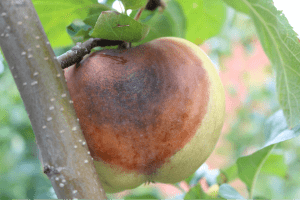What is White Rot?
White Rot is a fungal disease of apples and pears caused by Botryosphaeria dothidea, also called Botryosphaeria rot or bot rot. The symptoms can be easily confused with Black rot (Diplodia seriata) and Bitter rot (Colletotrichum gloeosporioides). Externally, all three diseases have similar symptoms, and begin as small light brown to red lesions that may have a red halo. There are some key differences between white rot and the others that can help differentiate between them. White rot develops as a cylindrical lesion to the fruit core and eventually overtakes the entire fruit (Picture), while bitter pit remains a cone shaped lesion that does not enter the core. White rot develops circular brown lesions like black rot, however, black rot lesions remain firm and flat while white rot lesions sink and appear watery.
What does White Rot look like?
White rot infects fruit tissue as well as woody stems and twigs. On woody tissue, infection begins as small reddish-brown blistering lesions, which gradually become depressed areas as the cankers grow in diameter and the dermal cells collapse. Mature cankers have a papery bark that ranges from tan to orange with a purple border. Pycnidia and pseudothecia form in cankers and spore release leads to secondary infections in the wood and fruit.
In apples, Bot rot initially appears late in the growing season within 4 weeks of harvest, making control difficult. Botryosphaeria lesions show as small brown spots with a red halo on the surface of the fruit, but may appear darker purple in cultivars with red pigmentation. The lesions will grow in diameter, and extend in a cylindrical pattern towards the core. As mentioned above, this pattern is a clear distinction to bitter rot, which expands in a V-shaped pattern and can help differentiate the diseases. Eventually the rot will completely overtake the fruit and leave it pale, soft, and watery. The rot will typically cause fruit drop, but some may remain on the tree, become mummified, and act as a source of inoculum for the next season.
Where does White Rot Come from?
The wide host range of B. diplodia can cause forests surrounding orchards to be a ready source of infection, however, most spore dispersal occurs within the orchard. The fungus overwinters in cankers and mummified fruit, but can also spread from pruned limbs during the growing season. The cankers produce conidia that is spread by rainfall, as well as ascospores which travel by wind. The disease spreads rapidly in warm and wet conditions, and infection can occur in a matter of hours. Botryosphaeria does not require a previous injury to spread, but removing damaged tissues is a way of preventing easy infection.
How do I prevent and control White Rot?
- Remove pruned limbs from the orchard completely. Do not leave at the border of the orchard, as they can act as a source of inoculum during the growing season
- Reduce water stress with proper irrigation
- Preventative fungicide applications can help reduce rate of infection
For more information on White Rot:
